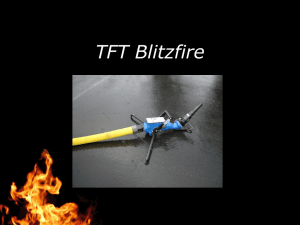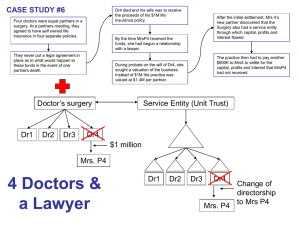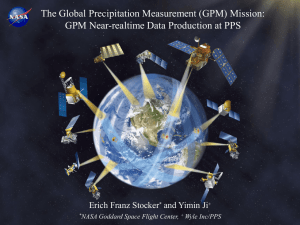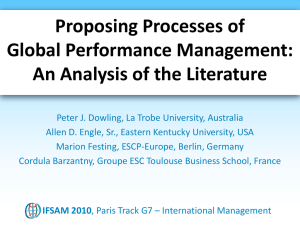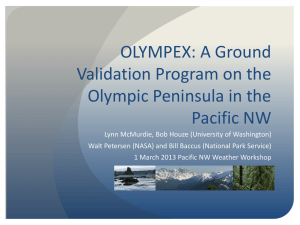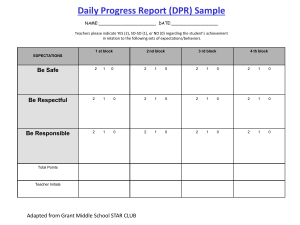Presentation - Copernicus.org
advertisement
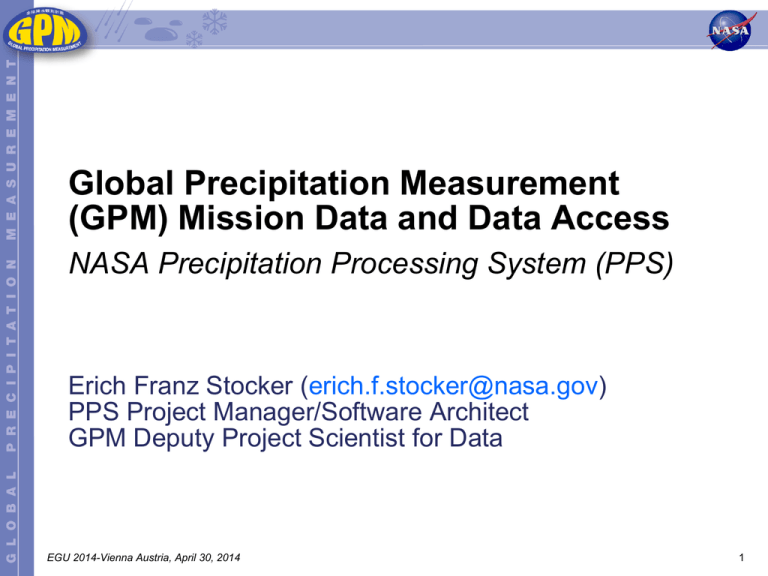
Global Precipitation Measurement (GPM) Mission Data and Data Access NASA Precipitation Processing System (PPS) Erich Franz Stocker (erich.f.stocker@nasa.gov) PPS Project Manager/Software Architect GPM Deputy Project Scientist for Data EGU 2014-Vienna Austria, April 30, 2014 1 EGU 2014-Vienna Austria, April 30, 2014 2 GPM Key Data Dates • February 28, 2014 3:30AM (JST) GPM Core Observatory launch from Tanegashima Space Center, Japan • March 4, 2014 GMI commanded to science observation mode and first data received • March 8, 2014 DPR commanded to science observation mode and first data received • March 21, 2014 GMI L1, L2 near-realtime (NRT) and L1, L2, L3 science standard data made available to set of early data adopters • April 2, 2014 DPR L2 NRT and L2 and L3 science standard data made available to set of early data adopters • April 2, 2014 Combined GMI/DPR L2 NRT and L2 and L3 science standard data made available to set of early data adopters • Current GMI, DPR and Combined data version is V01D both NRT and standard science EGU 2014-Vienna Austria, April 30, 2014 3 Data Release • End of June 2014 GMI data release to the international Precipitation Measurement Missions (PMM) science team • End of July 2014 DPR data release to the international PMM science team • End of August 2014 General public release • End of November 2014 General public release of new merged radiometer product (IMERG) EGU 2014-Vienna Austria, April 30, 2014 4 NRT GPM Core Data Products Processing Sat/Inst/Alg Level Size Latency Key Parameters 1B GPM/GMI 5 min <= 1Hr 90% Brightness Temperature-Tb 1C GPM/GMI 5 min <=1Hr ,90% Tb (future 1C reference) 1CR GPM/GMI 5 min <- 1Hr, 90% Intercalibrated Tb with matched HF and LF pixels 2A GPM/GMI/GPROF 5 min <=1Hr 90% Precipitation/TPW 2A Ku GPM/DPR/Ku 30 min <=180 min Reflectivities/3D Precipitation 2A Ka GPM/DPR/Ka 30 min <=180 min Reflectivities/3D Precipitation 2A DPR GPM/DPR/DPR 30min <= 180min Dual Frequency retrievals: reflectivities/3D precipitation 2B GMI/DPR GPM/GMI-DPR 30 min <=180 min 90% Combined GMI/DPR retrieval. 3D Precipitation 3 Merged Radiometers/IR Halfhour Early – 4 hours Late – 8 hours .1 deg x .1 deg global surface precipitation EGU 2014-Vienna Austria, April 30, 2014 5 1CR EGU 2014-Vienna Austria, April 30, 2014 6 NRT Constellation Products Processing Level Sat/Inst/Alg Size Latency Key Parameters 1C Metop B/MHS Noaa 18/MHS Noaa 19/MHS As received Provider dependent Intercalibrated Tb 1C MT/SAPHIR As received Provider Intercalibrated Tb 1C NPP/ATMS 1 Hr Provider Intercalibrated Tb 1C F16/SSMIS F17/SSMIS F18/SSMIS As received Provider Intercalibrated Tb 1C TRMM/TMI TDRSS <=180 min Reference Tb 1C GCOM-W/AMSR2 orbit ~120min Intercalibrated Tb 2A GPROF /MHS SAPHIR ATMS SSMIS TMI AMSR2 Same as 1C Same as 1C Precipitation/TPW EGU 2014-Vienna Austria, April 30, 2014 7 Standard GPM Core Science Swath Products Processing Sat/Inst/Alg Level Size Key Parameters 1B GPM/GMI GPM orbit (Gorbit*) Brightness Temperature-Tb 1C GPM/GMI Gorbit Tb (future reference) 1CR GPM/GMI Gorbit Tb with matched HF and LF footprint 2A GPM/GMI/GPROF Gorbit Precipitation/TPW 2A Ku GPM/DPR/Ku Gorbit Reflectivities/3D Precipitation 2A Ka GPM/DPR/Ka Gorbit Reflectivities/3D Precipitation 2A DPR GPM/DPR/ Gorbit Dual Frequency Retrievals. 3D precipitation 2B GMI/DPR GPM/GMI-DPR Gorbit GMI-DPR retrieval. 3D Precipitation * Gorbit is the GPM orbit calculated from the southern most point back to the southern most point EGU 2014-Vienna Austria, April 30, 2014 8 Standard GPM Core Gridded Products Processing Sat/Inst/Alg Level Size Key Parameters 3A GPM/GMI/GPROF 0.25 deg x 0.25 deg Daily/monthly Precipitation 3A GPM/DPR 0.25 deg x 0.25 deg Daily Precipitation Ascending/Descending separate 3A GPM/DPR 0.25 deg x 0.25 deg Monthly Precipitation 3B combined GPM/GMI-DPR 0.25 deg x 0.25 deg Daily/monthly Precipitation 3B Merged Merged Radiometers 0.10 deg x 0.10 deg Half-hr/monthly Gauge adjusted global precipitation EGU 2014-Vienna Austria, April 30, 2014 9 Standard Constellation Data Products Processing Sat/Inst/Alg Level Size Key Parameters 1C Metop B/MHS Noaa 18/MHS Noaa 19/MHS GPM orbit (Gorbit) Intercalibrated Tb 1C MT/SAPHIR Gorbit Intercalibrated Tb 1C NPP/ATMS Gorbit Intercalibrated Tb 1C F16/SSMIS F17/SSMIS F18/SSMIS Gorbit Intercalibrated Tb 1C TRMM/TMI Gorbit Reference Tb 1C GCOM-W/AMSR2 Gorbit Intercalibrated Tb 2A GPROF /MHS SAPHIR ATMS SSMIS TMI AMSR2 Same as 1C Precipitation/TPW 3A All instruments with GPROF 2A Daily monthly 0.25 deg x 0.25 deg Precipitation EGU 2014-Vienna Austria, April 30, 2014 10 Status of GPM Data Products-1 • Geolocation – Location on the ground reported within requirements – On April 19 Attitude Control System engineers reported an alignment error between start tracker and spacecraft leading to ~0.3 degree peak to peak attitude error (mostly roll) • This does have an impact on incidence angles which affect Tb calculation • New table scheduled to be uploaded April 25 • Data products will be adjusted as part of reprocessing for the PMM data release • GMI L1 products – Reasonably well calibrated (meets requirements specifications) – Small calibration changes in April that included in version V01D – Close to TMI calibration – Some RFI issues in 10 GHz and 18GHz channels (approach to flag and mitigate currently being examined.) • GPROF retrieval products – Saw more specific information in Dr. Kummerow’s presentation – Currently using initial non GPM a priori databases – New database approach for over land retrievals working reasonably well – Currently producing GPROF retrieval for partner imagers and testing sounders – Early state: some areas during really well and others not – Will need about one year of stable GMI L1C and GMI-DPR Level 2B data to establish physically based a priori databases for the GPROF retrievals for the radiometers EGU 2014-Vienna Austria, April 30, 2014 11 Status of GPM Data Products -2 • Ku/Ka L1B –radar powers – Have completed several external and internal calibrations – Have verified phase shifter commands – Reasonably well calibrated for this stage of the mission – Providing acceptable input for the radar L2 algorithms • Ku/Ka/DPR-retrievals – L2 are providing reasonable retrievals again at the early stage where better in some areas than in others – Matching of Ku/Ka pixels working – Some issues are being worked by JAXA engineers and DPR algorithm team • Combined GMI-DPR – Very early stage of development – Working on dealing with data input issues – Currently still in the experimental stage • IMERG (merged radiometer product) – Not being currently produced – Need stable GPROF retrievals for sounders as well as imagers – Currently in internal testing – Usually lags 3 to 4 months after stable L2 GPROF retrievals. EGU 2014-Vienna Austria, April 30, 2014 12 Sample Images of GMI and DPR EGU 2014-Vienna Austria, April 30, 2014 13 GPM Special Products • Daily gridded text products (like TRMM 3G68) – 0.1 deg x 0.1 degree – Contains: • GMI GPROF surface precipitation • Ku near-surface precipitation • Ka near-surface precipitation • DPR match swath near-surface precipitation • GMI-DPR Combined surface precipition – ASCII with line terminator being LF character • GIS compatible files for IMERG – TIFF (precipitation) with world files for metadata – Precipitation in TIFF is scaled integer – Half-hourly, 1day, 3 day and 7 day accumulations EGU 2014-Vienna Austria, April 30, 2014 14 Accessing GPM Data • Must register an email. – registration.pps.eosdis.nasa.gov – Receive an email and click to confirm – Can specify interest in either standard science, NRT or both • Can do ftp to the archive using your registered email as user name and password • Can use a query/order web interface – storm-pps.gsfc.nasa.gov or storm-pps.pps.eosdis.nasa.gov – Can query, place orders for specific products, or establish standing orders which will be fulfilled as products are generated – Can subset swath products and get only the subsets specified • Geographically • Parameter (e.g. just include geolocation and surface precipitation) • Or both together • Currently limited as to the number orderable to keep within scope – Can establish standing orders for subsets – Can see browse images of the orbit to help in ordering decisions – Can look through the data product online • File specifications and algorithm theoretical basis documents (ATBD) – pps.gsfc.nasa.gov/GPMprelimdocs.html EGU 2014-Vienna Austria, April 30, 2014 15 Tools and Services • THOR – Tool for looking at GPM data products – Includes functionality for making images including 3D images – IDL based but IDL not required – Available for: Linux, Windows, Mac OS – http://pps.gsfc.nasa.gov/thorrelease.html • Subsetting available for multiple years (STORM currently limits) – erich.f.stocker@nasa.gov – Carol.L.Archambeault@nasa.gov – Includes setting up subsets to support field campaigns • 3 Hr Presentation (Data and data access) – Includes • More detailed data description,strengths,limitations and status • HDF5 format and tools for accessing • Useful documentation • Accessing data including the writing of scripts for automated access • Use of THOR, STORM – Can with planning offer the tutorial at Universities and agencies – After a couple of presentations to get user feedback will package the presentation – Contact: erich.f.stocker@nasa.gov EGU 2014-Vienna Austria, April 30, 2014 16

